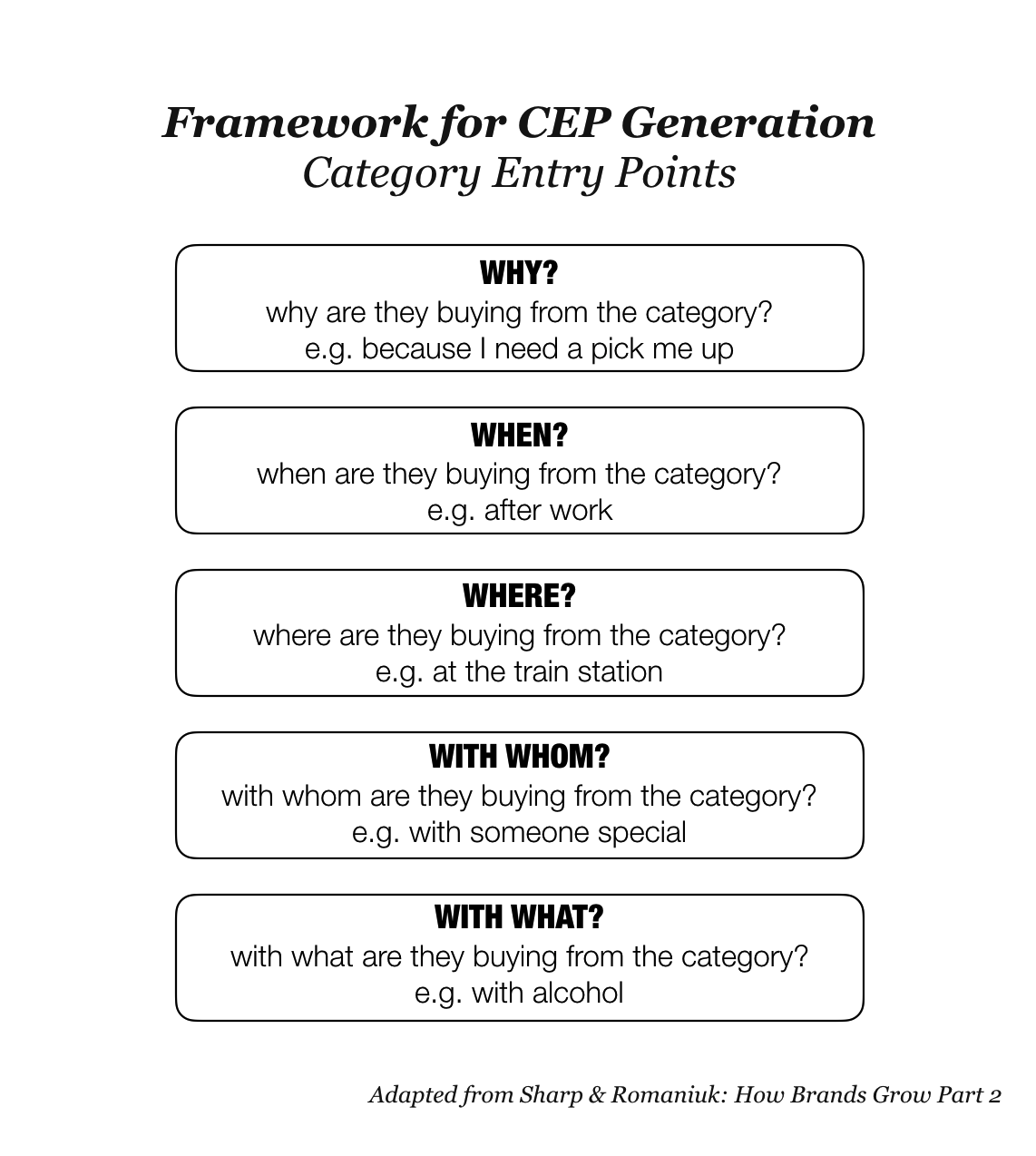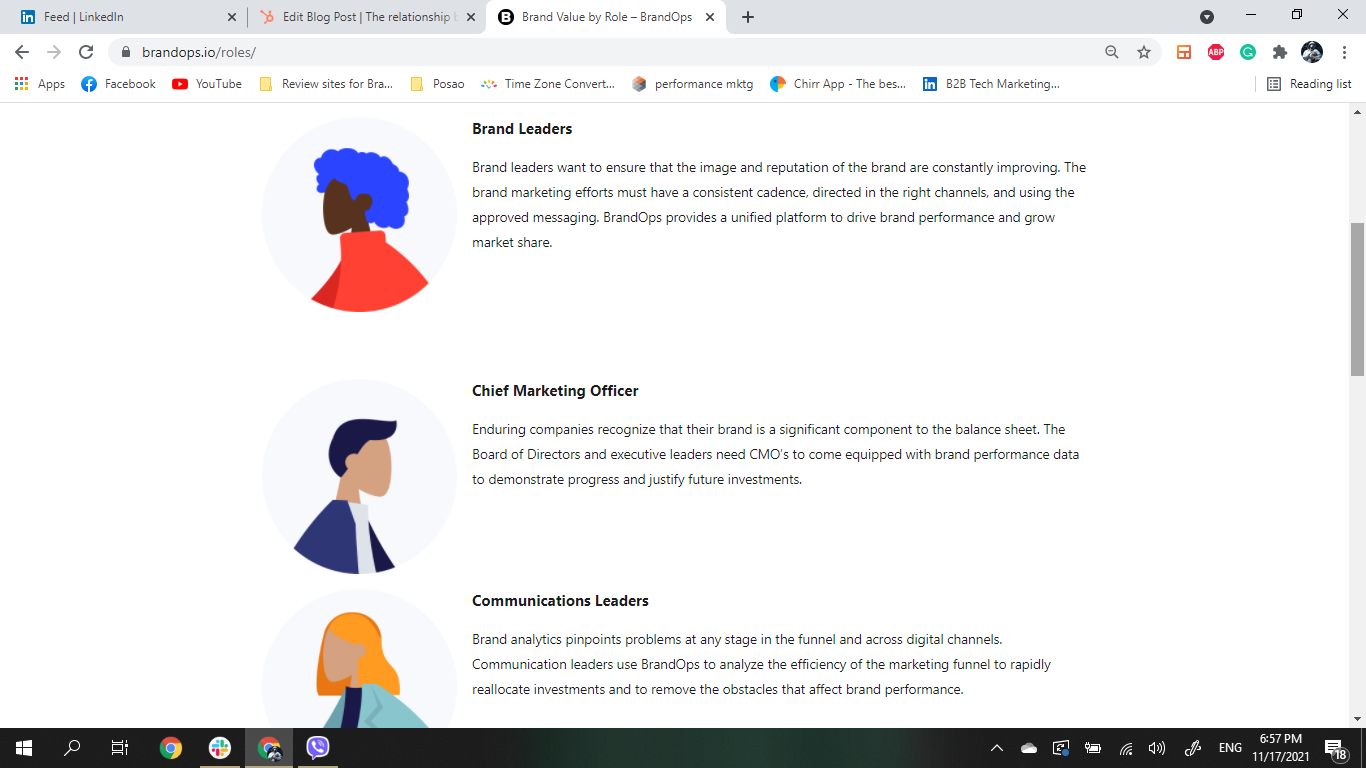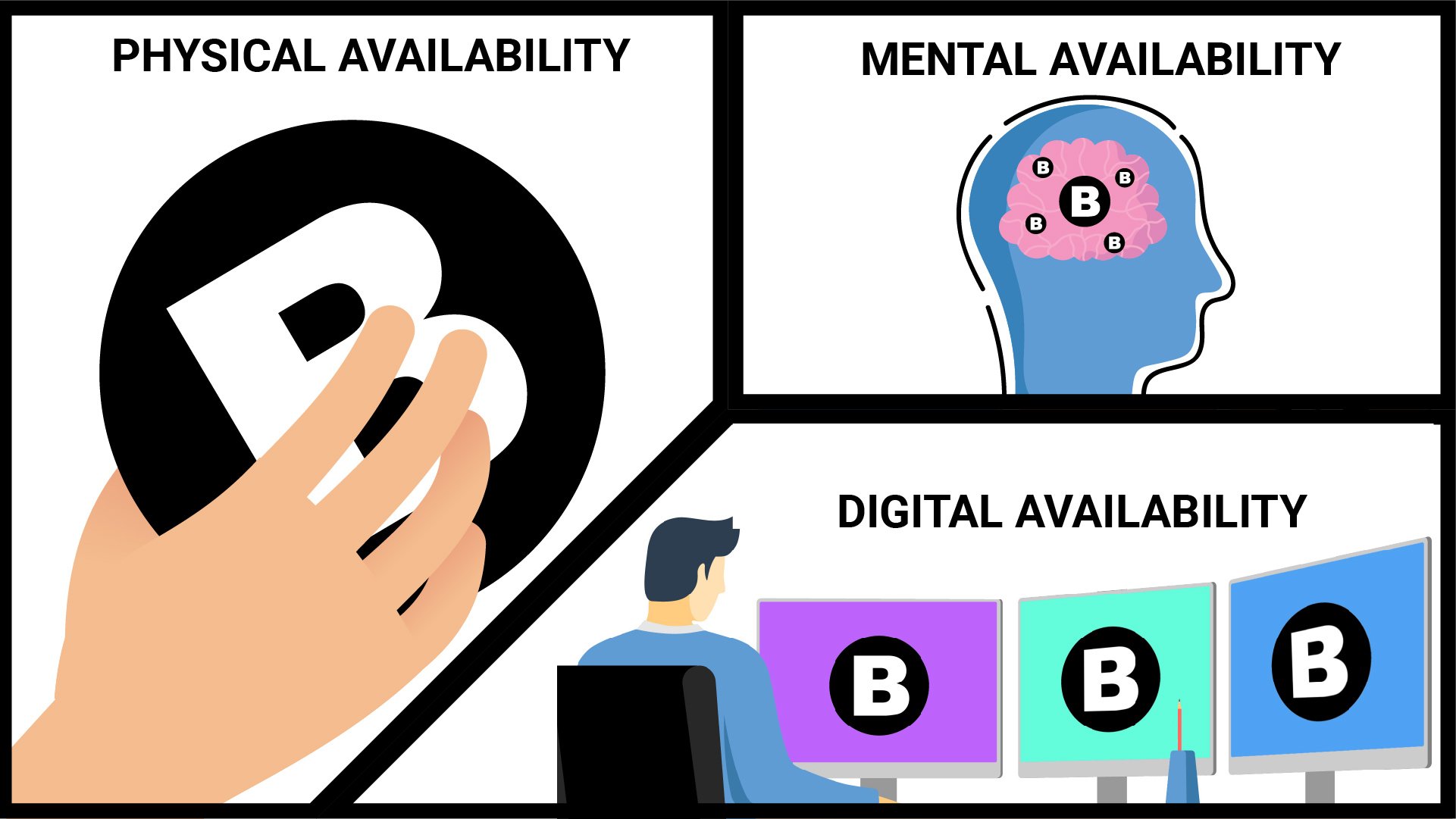How Category Entry Points apply to digital marketing
6 minute read
Category Entry Points (CEPs) are the reasons, triggers, or occasions when someone considers buying a product in your category. Brands have an interest in being mentally attached to CEPs to get bought more often by more people. As such, CEPs are a form of mental availability. As a concept, they originate from the Ehrenberg-Bass Insitute. A very similar model that is popular amongst marketers in tech and B2B is called Jobs To Be Done (JTBD) model. 
While they can be a powerful competitive moat for any brand, the problem with CEPs is that they are often presented in an abstract way. Not much is said about CEPs, other than what they are and how leading brands establish them by big, expensive offline advertising campaigns (TV being the most effective channel). Many brands don't have a budget to make those TV advertising success stories relatable or useful.
This blog post fills the gap between brand experts and execution-level digital marketers by explaining the practicalities of CEPs: how they relate to major digital marketing concepts, how your brand can use them, and how BrandOps can measure them.
CEPs + intent data
In a form of digital brand signals, the same CEPs can manifest in various ways based on the type of customer intent: research, evaluation, or buying intent. This will happen if a buyer doesn't already have a mental connection between that CEP and any category brand. This adds to the complexity of CEPs that isn't explained in their theoretical form. Because CEPs vary based on the intent and the funnel stage behind them, brands need to carefully think about how they distribute their brand digitally to meet these CEPs. The relationship between CEPs, the intent data, and the digital signals they show up in are not mutually exclusive. One digital brand signal could be interpreted as belonging to multiple different CEPs, which can be very confusing if you don't have metadata to support it. By that point, you'd be making guesses.
Example: I need new ABM software for Q1 because my company is going through a digital transformation and the ABM stack we currently use is now obsolete (Category Entry Point).
Google search (research intent phrase): "How to implement ABM software" (digital signal, search)
Google search (evaluation intent phrase): "Best ABM software 2021" (digital signal, search)
Google search (buying intent phrase): "ABM software price comparison" (digital signal, search)
CEPs + SEO & PPC
If CEPs are the set of wants, triggers, and circumstances that create a demand for the category within the minds of customers, then search terms are a written declaration of them. Brands leverage their existing CEPs on search by establishing a presence for phrases and keywords relevant to said CEPs. They can vary based on the search intent. Brands can link new CEPs to their brands by appearing on SERPs relevant to CEPs long enough. Alternatively, brands can "steal" buyers who start the purchase path on search through CEPs the brand doesn't already own by investing in PPC. This is a form of physical availability. Showing up where buyers are looking, even though they didn't have your brand in mind when they turned their CEPs into search queries.
The extent of how well your brand is connected to certain CEPs is reflected in organic search results. In any category, most buyers are casual and make for the vast majority of total category purchases. This is why brands that own the category-generic CEPs (and thus, category-generic search terms) are usually the category leaders. If only a few brands appear on the generic category search terms, that means the category is small. If you aim to become the category king, you have to either win on the generic category search terms or win many smaller ones to offset the difference of not winning the generic one. This is proven by the Share of Search model.
This is a rule of thumb and it doesn't always apply - a good example of this is GoPro! If GoPro competed on the category generic "camera" search term, they wouldn't even make the top 50 of the list. Instead, they carved out a subcategory (and thus, subcategory search terms) where they outperform many category-generic players.
CEPs + social media
Social media is a powerful top-funnel digital channel that can be used to win new CEPs. This is because brands use social media to engage in conversations with category buyers, tell stories and educate potential buyers on how the brand could benefit them. The principles of winning CEPs on social media are the same as anywhere: tell a CEP-winning story to your target group for a long period of time until the CEPs become one with your brand. There's a major caveat: to communicate your CEP-winning story on social media, people have to willingly opt-in to hear what your brand has to say by becoming your social media followers. This requires brands to go the extra mile with their efforts to be relevant and interesting because the attention they get is hard-earned. The limitation of social media (especially organic) is its small reach. Unlike brand advertising (on any channel) which can distribute the CEP-building story directly and continuously to a broad group of people, social media channels are limited to the people who already follow you or are in the social media network of people who follow you. This means your CEP-winning story is delivered sporadically.
Establishing CEPs requires many people to consume your CEP-building message over time. Having people miss your message (because they aren't following you, and thus aren't exposed to your message consistently) will make it very hard to do this. Brands who succeed at establishing CEPs organically on social media are outliers: thought leaders with big followings to make CEP building worth it, highly differentiated brands with advocates that willingly spread the brand's message, and so on. Otherwise, brands' safest choice to offset these limitations is by investing in paid social to distribute stories that will win CEPs. Even if a brand isn't faced with these problems, investing in paid social will still amplify things that are already performing well for your brand.
CEPs + Website
In the purchase paths that take place online, your website is the destination to which your brand's CEPs lead. There, brands can either use the website visitors' undivided attention to expand on the established CEPs, or make a case for new ones. The former usually attracts buyers who are actively shopping and are clear in what they want from the start (because the CEPs your brand owns acted as a purchase intent trigger). If the brand owns generic CEPs, it will be reflected in a high volume of branded traffic and direct traffic relative to the competitors - this can be measured in BrandOps. Establishing new CEPs for the long term through a website will be possible only if the website enjoys a significant volume of traffic, and is used frequently as a source of education on the brand over a long period of time. This is because frequent website visitors will be exposed to CEP-building messages over prolonged periods of time, as it's impossible to win CEPs without exposure. One example of how brands do this is by publishing blogs on their website.
Additionally, the likelihood of establishing new CEPs through your website will depend on the website visitor's intent: are they casually scrolling, or are they shopping? If they've casually stumbled upon your website, unless the new CEPs you intend to capture are communicated outside the website, and unless you have a plan to keep these casual visitors coming back to your website, the likelihood of them associating the CEPs with you is low. However, if they are actively shopping and they see new CEPs on your website your brand isn't currently associated with, it can give them more buying options and your new CEPs will be remembered (albeit for a short time for as long they are in the buying mode). This is because buyers with high intent tend to make shortlists of brands when evaluating options - a common practice in B2B. Brands can increase the chances of new CEPs sticking in active buyers' minds by investing in retargeting ads to remind shoppers of your brand's new CEPs and their relevance to buyers.
Examples of CEPs, both owned and aspirational can be seen in "use cases" sections on various brand websites (especially in B2B):
CEPs + digital brand advertising
"Establishing the observation that there is just one black swan falsifies "all swans are white."
- Nassim Nicholas Taleb
Digital brand advertising is the most powerful DIGITAL method in attaching your brand to new CEPs. An important emphasis is on the word "brand" because digital advertising can be brand advertising (long term) and direct response advertising (short term). Because most digital marketing tactics, tools, and professionals are focused on short-term marketing, the stereotype is that all digital ads are inherently short-term. This is not true.
Whereas big brands use a plethora of both online and offline channels in their mix, brands that fight for CEPs through digital brand advertising are constrained by digital channels. Brands that use digital brand advertising to capture new CEPs should be aware that the constraints to digital channels mean less reach potential (in comparison to unconstrained advertising). Digital brand advertising still offers effective choices for winning CEPs - online video (which includes VOD, YouTube, Facebook video, OTT) is one powerful example of this. The advantage digital brand advertising has is the ability to tap into online channels and communities where the target audience frequents - the channels offline advertising may not always be able to tap into. Again, this is very powerful in certain B2B or niche categories, where brands are discovered and bought almost exclusively online.
The conclusion
CEPs are built primarily through long-term brand advertising (mental availability driver), and its benefits are captured through digital channels (physical availability channels). On the digital-only side, digital brand advertising is the most effective option for creating new CEPs. While other channels are able to build CEPs passively, they are a weak force that, being as weak as they are, still require many pre-conditions to succeed. It can still work out for brands that are creative, strategic, and resourceful enough.
Fighting for CEPs is a long-term journey that requires many resources. Attempting to win CEPs without sufficient resources will entice you to think about whether that's currently your priority, and whether the investment is worth the outcome (and whether the outcome will even happen). It's often better to postpone fighting for new CEPs for when you can afford to go all the way - not only to increase your effectiveness but to also reduce your risk.
Thank you for reading this blog post. We hope we brought some light to the practical reality of Category Entry Points.
If you wish to see how your brand's CEPs are reflected in your performance across all digital channels, schedule a BrandOps demo with our team.

BrandOps is a unified brand tracking and measurement platform that provides digital-first marketers
with a continuous view of marketing performance and pinpoints areas that need improvement.


